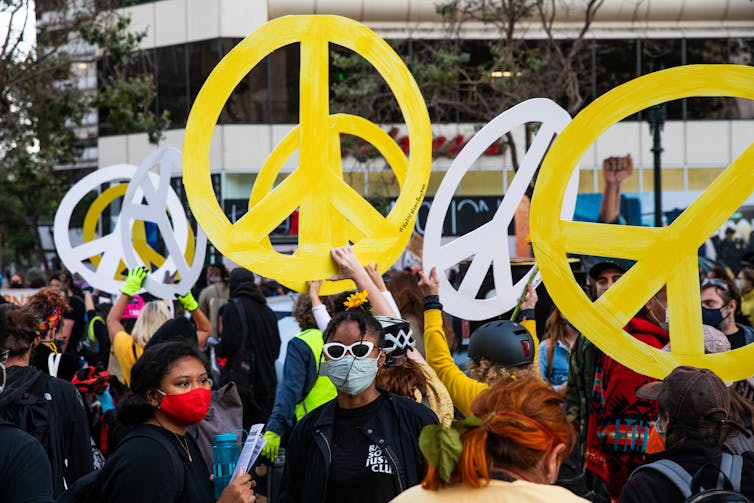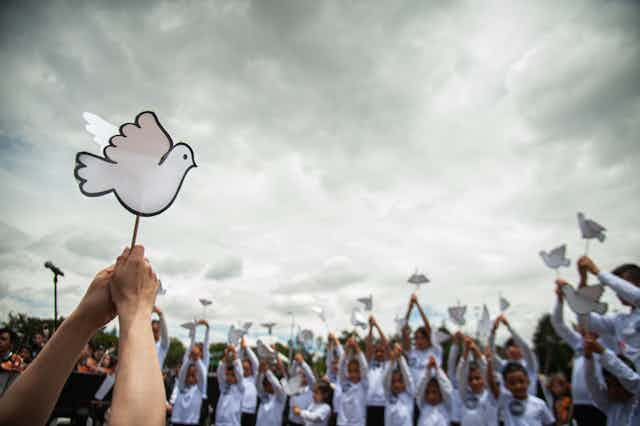Americans don’t talk much about peace. But it turns out they care about it a lot – they just don’t talk about it the way people who have experienced war or civil conflict do.
When public opinion polls in the U.S. ask people about peace, it’s either in the context of religion or world peace.
Instead of using the word peace, Americans are more likely to say that they care deeply about safety and security and issues like terrorism, crime, illegal drugs and immigration.
But they still care about the same things people in places that have faced war are focused on.

What is peace?
We are social scientists who are part of a network of peace and conflict researchers and community-engaged scholars at several universities. We and our other colleagues have spent a lot of time talking with different communities that have experienced war, including in Colombia, Afghanistan and Bosnia and Herzegovina, about what peace looks like to them.
Peace is hard to define. In the dictionary, it’s equated with tranquility or the absence of war. We see it as broader. Peace is the ability for people to live in harmony with themselves and with each other. In practice, however, that can mean many different things to different people.
We know that people who directly experience conflict and violence tend to have very broad, but also nuanced, definitions of peace.
In Colombia, for example, many communities told us they felt at peace when they had the infrastructure necessary to supply basic needs, like clean water, or when they could actively participate in regular social gatherings. In Bosnia, residents highlighted the ability to use public spaces, including rebuilt ruins from the war, as well as the presence of more day-to-day amenities like streetlights and parking.
But until a recent project in Oakland, California, we weren’t thinking about our work in America as also being about peace.
Since 2021, we’ve been working with six community organizations in Oakland to understand how people define and experience safety and well-being in their everyday lives. As it turns out, these concepts helped us get at how Americans, who have not experienced war like the people in other regions we’ve worked with, might also understand peace.
Re-imagining safety
Our research’s focus on safety was inspired by a number of cities and towns, like Columbus, Ohio, and Austin, Texas, that have launched projects to reform how public safety is conceived of and protected following the widespread Black Lives Matter protests in 2020.
Oakland has undergone a similar process of asking residents to help their local government rethink what safety means. And, like other cities, Oakland residents have had an intense debate over the police department and how the government should reform its approach to crime.
We spoke to over 500 residents across parts of Oakland that have been especially hard hit by crime and violence and who live in areas that have historically been both overpoliced and underserved with public resources.
We asked questions like, “What does safety or the lack of safety look like here,” and “What are some signs that the community is doing well or not doing well?”
These conversations covered a lot of ground – ground that was similar to other conversations we’ve had about peace with people who live in conflict zones or countries with long histories of war.
Some Oakland residents spoke about how kids are desensitized to gunshots and violence or are arrested or kicked out of their homes. We heard that these kids and teenagers ultimately lose sight of how their lives – and the lives of others – have value.
High school students also reflected on the prevalence of guns, shootings and gangs in their lives. As one told us, “I want to go back” to a more innocent time, when “I didn’t know nothing about any of this.”
But just as we know that violence and security are only two aspects of people’s understandings of peace, the same is true of safety. The police – and even crime – are just two aspects of how communities think about safety in their everyday lives. They also think about economic opportunities, public space and social connections.
We heard about how, when kids have basic life skills and job skills training, or have mentors and role models, this can give them choices that are alternatives to criminal activity and help them invest back in their communities.
We heard about block parties and town nights, which inspire people of different races and ethnicities to look out for each other and build trust with their neighbors. “By us, for us,” as one resident put it.

From safety to peace
The United Nations marks the annual International Day of Peace on Sept. 21, 2023.
In general, the U.S. does not widely recognize or celebrate global holidays like these, including International Women’s Day or International Labor Day .
But, like peace, safety is about far more than reducing violence. It’s being able to trust that police have communities’ interests in mind and knowing that residents will receive fair treatment in the courts.
It’s also being able to breathe clean air and access work and educational opportunities. It’s about being able to openly share past trauma, feel loved and connected, and so much more.
This all has important implications for what Americans want – and what they actually get – from their local governments. When policymakers define safety as the absence of violence and benchmark it primarily against metrics like crime statistics, they limit the kinds of policies that cities and their residents can look to.
Typically, the main policy responses in the U.S. to crime and violence have centered on policing and incarceration.
In contrast, our conversations across Oakland suggest that communities are already using different frameworks and language to assess safety. These in turn offer up a more holistic set of potential interventions. What, we might ask, would city leaders focus on if they were evaluating the success of public safety reforms by whether children are playing outside in the park, or whether people know the names of their neighbors?
Building safety in the U.S. is more akin to building peace internationally than many Americans may think. As we celebrate world peace, we think people should remember that these conversations matter here at home, too.

